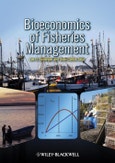The book is broken into two parts. Part I covers the traditional areas of fisheries economics, covering topics such as open access, optimal and managed fisheries utilization that is analyzed through a traditional one stock/one fleet model. It also presents the basic results in terms of an age structured model. Part II covers material related to more recent work on bioeconomic models when more rigorous biological components became more prevalent, and views fisheries management with an ecosystems-based approach. Accompanying the book is a user-friendly CD with exercises and examples that aids the reader in applying theoretical principles of population dynamics and fisheries management and regulation. Bioeconomics of Fisheries Management will be a valuable text for researchers, fisheries economists, professionals, and students alike.
Table of Contents
Preface ix
Acknowledgments xi
1 Introduction 3
1.1 Why is fisheries management and regulation needed? 3
1.2 The social trap and free rider behavior in fisheries 5
1.3 Stock fluctuations due to natural causes 5
1.4 Fisheries Bioeconomics 6
References 10
2 Fundamentals of fisheries Bioeconomics 11
2.1 Introduction 11
2.2 The Schaefer logistic growth model 12
2.3 Schaeffer logistic growth with harvest 15
2.4 A more formal analysis of commercial harvest 17
2.5 The basic Bioeconomic model 21
2.6 Deriving revenue and cost functions 21
2.7 Static maximum economic yield 24
2.8 Open access utilization of a fishery 25
2.9 Postscript on structural change under open access 28
References 29
3 Open access dynamics 31
3.1 Introduction 31
3.2 Bioeconomic equilibrium 31
3.3 The process of obtaining an equilibrium 34
3.4 Bioeconomic equilibrium in a disaggregated model 39
4 Optimal dynamic utilization 51
4.1 Introduction 51
4.2 The general model with nonlinear yield functions 53
4.3 Formal analysis of optimal dynamic utilization 59
4.4 Interpretation of the Golden Rule 63
References 71
5 Age-structured Bioeconomic model 73
5.1 Introduction 73
5.2 The age-class Bioeconomic model 76
5.3 The details of the age-class Bioeconomic model 81
5.4 Biological analysis with age class model 87
5.5 Population dynamics in age-class models 93
5.6 Bioeconomic analysis with age-class models 97
References 102
6 The fisheries management process 105
6.1 Introduction 105
6.2 The paradigm of modern fisheries management 105
6.3 Historical perspective on the development of the paradigm 107
6.4 The specification of harvest control rules 109
6.5 Limit and target harvests 112
6.6 Monte Carlo results with scientific uncertainty 114
6.7 Monte Carlo results with scientific and implementation uncertainty 115
References 118
7 Economic analysis of fishery regulation 121
7.1 Introduction 121
7.2 Introduction of regulation discussion 126
7.3 Open access regulations 128
7.4 Limited-access regulation 159
References 177
8 Bioeconomics of ecosystem interdependencies 181
8.1 Current challenges of the ecosystems approach to fisheries 183
References 187
9 Ecological and technological interdependencies 189
9.1 Implicit form equations 190
9.2 Growth functions of ecologically interdependent species 190
9.3 Case 1: competition – the Lotka–Volterra model 194
9.4 Case 2: Bioeconomics of predator–prey interdependencies 203
9.5 Case 3: fleets with heterogeneous fishing power and unit costs of effort competing for a stock 211
9.6 Case 4: multispecies and multifleet fishery – a fleet harvesting incidentally target species of another fishery 217
9.7 Case 5: sequential technological interdependencies of small-scale and industrial fleets – an age-structured model 224
9.8 An age-structured sequential Bioeconomic model 225
References 229
10 Spatial management of fisheries 231
10.1 Spatially distributed population of a single stock 233
10.2 Distance from port to alternative fishing sites 236
10.3 Spatial fishing behavior 237
10.4 Spatial management of fisheries 244
10.5 A metapopulation with source–sink configuration 248
10.6 A Bioeconomic model for source–sink configurations 249
10.7 Migration in spatial models of fisheries 251
10.8 Final remarks 253
References 253
11 Seasonality and long-term fluctuating stock 257
11.1 Introduction 257
11.2 Modeling recruitment seasonality 258
11.3 Optimum allocation of seasonal effort 260
11.4 Long-term patterns in small pelagic fisheries 261
11.5 Long-term pattern of fluctuating environmentally driven recruitment 265
References 269
12 Dealing with risk and uncertainty 271
12.1 Cimate change increases uncertainty in marine fisheries 272
12.2 Indicators, reference points, and control law 274
12.3 Case 1: selecting adequate vessel size for a stock fluctuating fishery 276
12.4 Bayesian criterion 277
12.5 Decision criteria without mathematical probabilities 277
12.6 Case 2: stock recovery strategies of a multifleet fishery with alternative biomass LRPs 280
12.7 Probability of exceeding a spawning stock LRP in the stock recovery process 283
References 284
Appendices 287
1 Spatial dynamics of the fishery for three possible strategies of spatial behavior of fishers 287
2 Modelling recruitment seasonality 291
3 Summary of model equations and Bioeconomic parameter sets 293
Index 297








